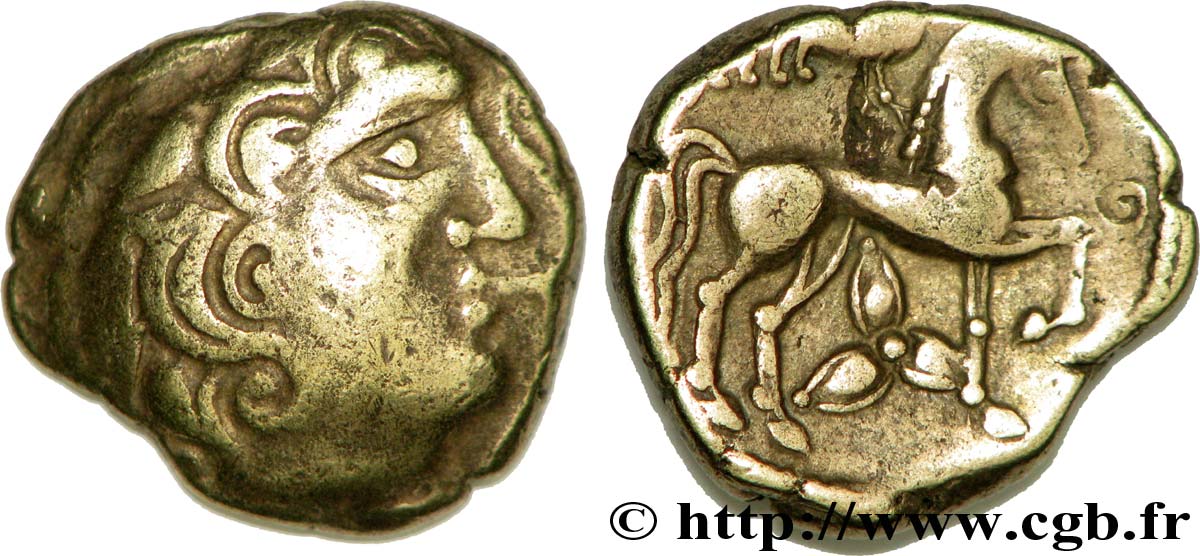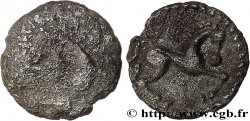v41_1561 - GALLIA - LEMOVICES (Regione di Limoges) Statère à la grue
MONNAIES 41 (2009)
Начальная цена : 1 400.00 €
Назначить цену : 2 000.00 €
непроданный лот
Начальная цена : 1 400.00 €
Назначить цену : 2 000.00 €
непроданный лот
Тип Statère à la grue
Дата: c. 100-50 BC.
Монетный двор / Город: Limoges (87)
Металл: electrum
Диаметр: 18 mm
Ориентация осей монеты: 12 h.
Вес: 5,9 g.
Редкость: R2
Комментарии о состоянии
Exemplaire sur un flan relativement large, mais irrégulier. Droit complet et centré, avec l'accolade en bord de flan devant la bouche. Revers de frappe vigoureuse, mais avec un léger défaut de flan au-dessus du cheval et avec la grue partiellement hors flan. Sinon cheval et trèfle complets, avec une belle patine rose d’électrum
Ссылки в каталоге: :
Лицевая сторона
Аверс: легенда: ANÉPIGRAPHE.
Аверс: описание: Tête à droite, la chevelure en grosses mèches aquitaniques.
Обратная сторона
Реверс: легенда: ANÉPIGRAPHE.
Реверс: Описание: Cheval à droite, une grue posée sur la croupe et un trèfle entre les jambes.
Комментарий
Cette variété correspond à la classe II de la série 1076 “à la grue et au trèfle” du Nouvel Atlas.
L’oiseau posé sur la croupe du cheval est en bord de flan sur cet exemplaire, mais tout le reste des types de droit et de revers est parfaitement bien venu, avec un cheval complet et un très beau trèfle.
Le motif d‘accolade partant de la bouche, devant le visage, est parfois interprété comme le signe de la parole ; on retrouve ce détail sur les statères des Bituriges, mais aussi sous forme des deux dauphins, plus ou moins stylisés, sur la plupart des monnaies d’argent du sud, dites “à la croix”. On notera qu’au revers, le cheval a lui aussi une sorte de volute qui lui sort de la bouche.
This variety corresponds to class II of series 1076 “with crane and clover” of the New Atlas. The bird perched on the horse’s rump is on the edge of the flan on this example, but all the rest of the obverse and reverse types are perfectly well-placed, with a complete horse and a very beautiful clover. The brace motif starting from the mouth, in front of the face, is sometimes interpreted as the sign of speech; we find this detail on the staters of the Bituriges, but also in the form of the two dolphins, more or less stylized, on most of the southern silver coins, called “with the cross”. It should be noted that on the reverse, the horse also has a sort of volute coming out of its mouth
L’oiseau posé sur la croupe du cheval est en bord de flan sur cet exemplaire, mais tout le reste des types de droit et de revers est parfaitement bien venu, avec un cheval complet et un très beau trèfle.
Le motif d‘accolade partant de la bouche, devant le visage, est parfois interprété comme le signe de la parole ; on retrouve ce détail sur les statères des Bituriges, mais aussi sous forme des deux dauphins, plus ou moins stylisés, sur la plupart des monnaies d’argent du sud, dites “à la croix”. On notera qu’au revers, le cheval a lui aussi une sorte de volute qui lui sort de la bouche.
This variety corresponds to class II of series 1076 “with crane and clover” of the New Atlas. The bird perched on the horse’s rump is on the edge of the flan on this example, but all the rest of the obverse and reverse types are perfectly well-placed, with a complete horse and a very beautiful clover. The brace motif starting from the mouth, in front of the face, is sometimes interpreted as the sign of speech; we find this detail on the staters of the Bituriges, but also in the form of the two dolphins, more or less stylized, on most of the southern silver coins, called “with the cross”. It should be noted that on the reverse, the horse also has a sort of volute coming out of its mouth








 Cообщить об ошибке
Cообщить об ошибке Распечатать страницу
Распечатать страницу Отправить мой выбор
Отправить мой выбор Задать вопрос
Задать вопрос Consign / sell
Consign / sell
 Информация
Информация











